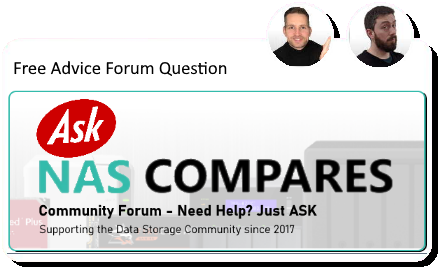Posts: 1,071
Threads: 1,072
Joined: Feb 2020
Reputation:
2
I'm trying to upgrade a TS-873 (8x3TB HDDs with 24TB gross capacity) to an All Flash NAS > QTIER with an 8-bay 4TB SATA SSD + 4 NVMe RAID 10 storage pool + 10/25GbE network. Has anyone tried this, and with what results? My experience with this NAS has been disappointing! Therefore, I'm looking at a TSV-h874X/T-i7 with the same idea. There's little to no online response to this topic!
I've had a QNAP support ticket open for over four months, with little interest and a lack of expertise, and only insufficient support!
My previous research refers to:
- https://nascompares.com/2022/12/16/qnap-tvs-h874-nas-review-ultimate-desktop-nas/
- https://www.club386.com/qnap-tvs-h874-8-bay-smb-nas-review-one-nas-to-rule-them-all/
and
- https://www.club386.com/qnap-tvs-h874t-thunderbolt-4-nas-review-empowering-creators
are, however, already 1.5 to 3 y old
Does anyone have experience with this and can support this Project?
Posts: 5,379
Threads: 2
Joined: Jun 2022
Reputation:
35
First, yes — your intended setup of 8 x 4TB SATA SSDs + 4 x NVMe in RAID 10 (with QTIER or potentially separating pools) is fully supported on the TVS-h874 series, and we’ve tested similar layouts in the lab with very good results. The ZFS-based QuTS Hero OS does particularly well with all-flash configurations, especially when you pair it with high-speed networking like 10GbE or 25GbE, as you’re planning. The main bottlenecks will typically come down to:
• NVMe drive thermal throttling (ensure active cooling or heatsinks with airflow)
• Network saturation (10GbE is great, but 25GbE gets closer to what NVMe RAID can deliver)
• QTIER vs. multiple pools (in many cases, manually managing two separate storage pools may yield better performance than trusting QTIER to move blocks automatically)
A few suggestions to make the most of your upgrade:
1. Avoid mixing SATA SSDs and NVMe into the same pool unless you’re using QTIER. For consistent IOPS and latency, it’s often better to create two separate pools — one for the SATA SSD array (RAID 6 or 10 depending on your balance of capacity vs redundancy), and one for NVMe (RAID 10 is excellent for speed and data protection).
2. Use SSDs with known high endurance (DWPD ≥ 1) for NVMe, especially in RAID 10. Enterprise or prosumer models like the Samsung 980 PRO, WD SN700, Seagate FireCuda 530, or Kingston KC3000 are popular.
3. Enable inline compression (especially Zstandard) and deduplication only if you have sufficient RAM — 32GB is the minimum, 64GB+ is ideal. This can substantially help performance and capacity on all-flash arrays.
4. Make sure to upgrade the firmware and QuTS Hero OS to the latest release. QNAP has been quietly improving SSD handling, NVMe thermal management, and 25GbE stability across recent versions.
5. Thunderbolt 4 support on the TVS-h874T is extremely valuable if you’re in a creative workflow (Final Cut, Resolve, Adobe). You can direct-connect a workstation at 2.8–3.2GB/s read/write with a tuned setup.





